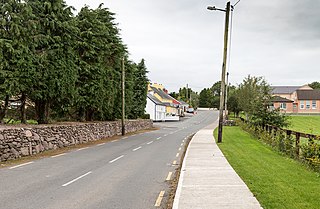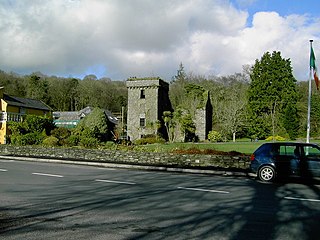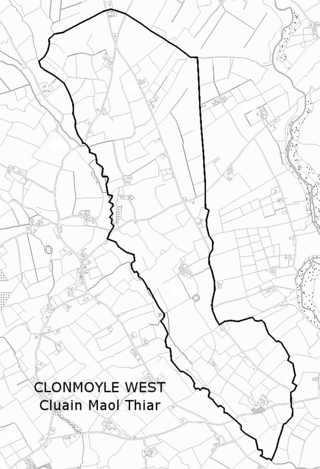
Aghabullogue or Aghabulloge is a village and parish in the barony of Muskerry East in County Cork, Ireland. It lies around 30 km (19 mi) west of Cork City, south of the Boggeragh Mountains and north of the River Lee.

Ballyvourney is a Gaeltacht village in southwest County Cork, Ireland. It is a civil parish in the barony of Muskerry West, and is also an ecclesiastical parish in the Roman Catholic Diocese of Cloyne. Ballyvourney is part of the Cork North-West Dáil Constituency.

Aherla is a small village in County Cork, Ireland, with a population of approximately 570. It is in the townlands of Aherla More and Rathard. Aherla is built on a limestone shelf typical of County Cork's ridges and valleys. The village is within the Cork North-West Dáil constituency.

Cúil Aodha, anglicised as Coolea, is a townland and village in the Gaeltacht region of Muskerry in County Cork, Ireland. The area is near the source of the River Sullane in the Derrynasaggart Mountains.

Carrigadrohid is a townland and village in the parish of Aghinagh, County Cork, Ireland. It is situated on the north bank of the River Lee, with the nearby village of Canovee to the south. Carrigadrohid is part of the Dáil constituency of Cork North-West.
Muskerry is a central region of County Cork, Ireland which incorporates the baronies of Muskerry West and Muskerry East. It is located along the valley of the River Lee and is bounded by the Boggeragh Mountains to the north and the Shehy Mountains to the south. The region is named after the Múscraige, who were an important Érainn people of Munster. It is also the name of an official Gaeltacht region in which Munster Irish is spoken. Gaeltacht villages include Béal Átha an Ghaorthaidh, Baile Bhuirne, Cúil Aodha and Cill na Martra. Major population centres include Ballincollig, Blarney and Macroom.

Farran is a village in County Cork, Ireland, in the parish of Ovens. It lies on the southside of the River Lee. Farran is 12 miles (19 km) west from Cork City on the N22 road.
Barretts is a barony in northwest County Cork in Ireland. The name is derived from the Old English Barrett family.

Kilculliheen is a civil parish, electoral division and barony in Ireland, on the north bank of the River Suir across from the centre of Waterford City. Historically, it has been transferred several times between the county of the city of Waterford and the counties of Kilkenny and Waterford. It now contains the only part of Waterford city on the left bank of the River Suir. The Parliamentary Gazetteer of 1846 states "as it lies on the left bank of the Suir, which, for the most part, divides co. Waterford from co. Kilkenny, most topographists mistakingly assign it to the barony of Ida, co. Kilkenny". It is now partly in County Kilkenny and partly in Waterford City. Of the barony's eleven townlands, five are entirely in Kilkenny and six are split between Kilkenny and Waterford. The city portion contains the formerly rural village of Ferrybank, which gives its name to a wider suburb which has spread across the county boundary.
Muskerry West is one of the baronies of Ireland, a historical geographical unit of land. Its chief town is Macroom. It is one of 24 baronies in the county of Cork. It may also be viewed as a half barony because sometime before the 1821 census, it was divided from its other half – Muskerry East. Other neighbouring baronies include Duhallow to the north and the Barony of Carbery East to the south.
Muskerry East is one of the baronies of Ireland, an historical geographical unit of land. Its chief town is Ballincollig. It is one of 24 baronies in the county of Cork. It may also be viewed as a half barony because some time before the 1821 census data, it was divided from its other half - Muskerry West. Other neighbouring baronies include Cork to the east, Duhallow to the north and the barony of Barretts to the north-east.

Aghavrin is a townland within both the civil parish and Catholic parish of Aghabullogue, County Cork, Ireland. It is 667.32 acres in size, situated south-west of Aghabullogue village, and north-west of Coachford village.
Moynoe is a civil parish in County Clare, Ireland. It is part of the Roman Catholic parish of Scarriff and Moynoe.

Carrignamuck is a townland within the civil parish of Magourney and catholic parish of Aghabullogue, County Cork, Ireland. It is 363.76 acres in size, situate north-east of Coachford village, and north-west of Dripsey village.

Clonmoyle East is a townland within both the civil parish and catholic parish of Aghabullogue, County Cork, Ireland. It is 756.05 acres in size, situate east of Aghabullogue village, and north of Coachford village.

Clonmoyle West is a townland within both the civil parish and catholic parish of Aghabullogue, County Cork, Ireland. It is 774.06 acres in size, situate east of Aghabullogue village, and north-west of Coachford village.
Moyaliff is an old Civil Parish and townland in County Tipperary, Ireland. The old Civil parish was in the barony of Kilnamanagh Upper in the County of Tipperary. It had thirty one townlands in total. Twenty seven of these townslands are in the Roman Catholic Parish of Upperchurch-Drombane, three in the Roman Catholic parish of Holycross-Ballycahill and one townland Moyaliff itself shared between the two.

Coologe is a townland in the civil parish of Templeport, County Cavan, Ireland. It lies in the Roman Catholic parish of Templeport and barony of Tullyhaw.

Matehy is a civil parish in the historical barony of Muskerry East in County Cork, Ireland. The civil parish is centred on a small settlement, also referred to as Matehy, which contains a Roman Catholic church, a national (primary) school, and pub. Evidence of ancient settlement in the area include ringfort sites in Gilcagh townland, and a circular ecclesiastical enclosure containing the remains of a church and a number of 18th century gravestones.
















